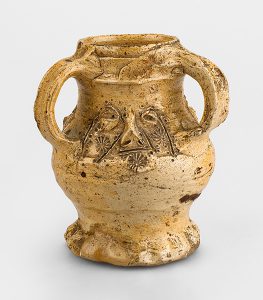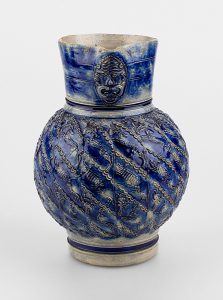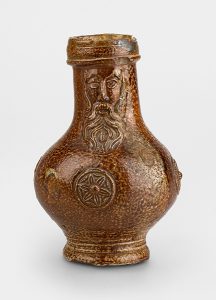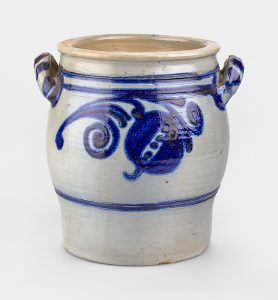



Andreas Heege 2019
Stoneware is a special type of pottery, usually fired at temperatures of between 1200°C and 1400°C with a largely vitreous, opaque, coloured fabric. It has a limited number of open pores and there are usually no tempering agents present or at least none that are visible. Early stonewares were often decorated with iron red slips or ash-glazes (places of production included Bengerode, Coppengrave, Reinhardswald and Bad Schmiedeberg in Germany). From the 15th century onwards, stoneware was increasingly covered in salt-glaze and by the 16th century, this had become the norm (Gaimster 1997, 46-48). Painted decorations using fire-resistant cobalt (smalt, blue) or iron manganese compounds (manganese violet) were not used until the 16th and 17th centuries.
The development from very hard-fired earthenware to partially vitrified near-stoneware occurred in the Rhineland region of Germany in the 13th century. Completely vitrified and untempered stoneware was first produced around 1300 in Siegburg near Bonn. Over the course of the subsequent centuries, various central European pottery and stoneware production centres sprang up in regions where high-quality clays were available (Germany, Belgium and France, and also England). Particularly worth mentioning are the production centres in western (e.g. Waldenburg) and eastern Saxony (e.g. Bad Muskau/Triebel) and the Rhenish areas of Siegburg, Cologne, Frechen, Langerwehe and Aachen; Raeren and Bouffioulx in Belgium, and from the late 16th century, the Westerwald region and the stoneware centres in the Alsace, and their later affiliates in Baden-Württemberg (e.g. Oppenau, Rotenfels).
It is often impossible to associate stoneware from the Westerwald region and its affiliates with specific places of production based on decoration or type and it must therefore be classified as “Westerwald-type” stoneware.
Due to a lack of certain types of clay in Switzerland, Austria and Liechtenstein and also in large parts of southern Germany, there was no stoneware production in the Middle Ages and considerable periods of the modern era in those regions.
Certain industrial wares from the second half of the 18th and 19th centuries that were fired at high temperatures and often left unglazed (dry-bodied caneware, black basaltware, jasperware, red stoneware) were originally developed in Staffordshire in England and later also produced by large pottery factories in mainland Europe and are difficult to classify. They are sometimes referred to as refined earthenware (Heege 2010, 59-66; yellow refined earthenware, black refined earthenware, red refined earthenware, blue refined earthenware), and sometimes as stoneware, even though the fabric is not always completely vitrified, and some types can also be lead-glazed. This terminological and technological problem prompted Michiel Bartels to classify them, as well as the normal white refined earthenware, as “industrial wares” (Bartels 1999, 240-259, industrial whitewares, industrial redwares; all others industrial wares). Recently these industrial wares have also been classified as “fine stoneware – Feinsteinzeug – grès fin” (Stellingwerf 2019, 42-46, 202).
Translation Sandy Haemmerle
German: Steinzeug
French: Grès, Proto-Grès
References:
Bartels 1999
Michiel Bartels, Steden in Scherven, Zwolle 1999.
Gaimster 1997
David R. M. Gaimster, German Stoneware 1200-1900. Archaeology and cultural history, London 1997.
Heege 2009
Andreas Heege, Steinzeug in der Schweiz (14.–20. Jh.). Ein Überblick über die Funde im Kanton Bern und den Stand der Forschung zu deutschem, französischem und englischem Steinzeug in der Schweiz, Bern 2009.
Stellingwerf 2019
Wytze Stellingwerf, The Patriot behind the pot. A historical and archaeological study of ceramics, glassware and politics in the Dutch household of the Revolutionary Era: 1780-1815, Zwolle 2019.

